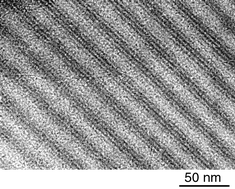Abstract
Patterns consisting of 10 nm stripes of Au55(PPh3)12Cl6 clusters have been generated by degradation of two-dimensional, ordered cluster monolayers on a water surface. Applying a modified Langmuir–Blodgett technique stripe formation is induced by fast withdrawing (10 cm min−1) of a substrate, deposited underneath the monolayer, under an angle of 20°. The stripes, each consisting of 3–4 cluster rows, show a separation of 8 nm from each other. Slow transportation of the substrate (2–3 cm min−1) led to hexagonal patterns of crossing stripes. This effect is attributed to the existence of partially overlapping islands of monolayers.


 Please wait while we load your content...
Please wait while we load your content...